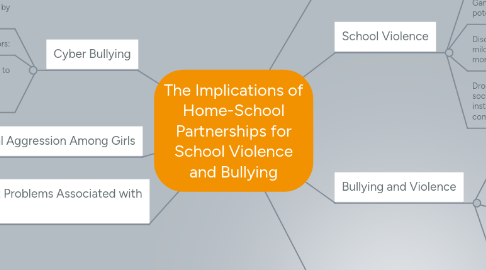
1. Cyber Bullying
1.1. Definition: Harassment of individuals by using electronic means
1.1.1. Task 1
1.1.2. Task 2
1.2. Risk factors:
1.2.1. More time spent online means the student is more likely to encounter safety issues
1.2.2. Lack of parental supervision
1.2.3. More harm is associated with cyber attacks than face to face confrontation
1.2.4. Manipulating identities
1.2.5. Sending Personal Information
1.3. -Depersonalization: Students pretend to be someone who they are not; harass others indirectly through electronic means. Attacks are
1.3.1. Call 1
1.3.2. Call 2
2. Relational Aggression Among Girls
2.1. Girls are more prone to participate in relational aggression
2.1.1. verbal forms of bullying are common in relational aggression
2.1.2. Flirting with others love interest with intent to hurt.
2.1.2.1. Meeting 2
3. Adjustment Problems Associated with Bullying
3.1. Bullies: Direct behavioral problems. At risk for falling victim to drug abuse, relational problems, dropping out of school
3.1.1. Direct behavioral problems outwards
3.2. Passive Victims: Victim of bully; act in shy, recluse manner
3.3. Provocative Victims: Victim of the bully; act in aggressive manner
3.3.1. Victim of the bully; act in aggressive manner
4. School Violence
4.1. The Ready Availability of Weapons: Weapons that are easily available escalate simplest of fights and disputes
4.2. Gang Membership: rituals and aggression add potential risk within schools
4.2.1. Task 1
4.2.2. Task 2
4.3. Discipline problems: Bullying and mild violence determine the risk for more serious violence in school
4.3.1. Call 1
4.3.2. Call 2
4.4. Dropping out: Difficulty conforming to the social and behavioral demands of institutions are at great risk for committing violent acts
4.4.1. Meeting 1
4.4.2. Meeting 2
5. Bullying and Violence
5.1. Bullying definition: “The purposeful infliction of psychological or physical pain on one individual by another or by a group.”
5.2. Bullying Behaviors: Harassment of others, social ostracism and friendship interference
5.2.1. Task 1
5.2.2. Task 2
5.3. Parent School Partnerships: Helps reduce violence, substance abuse and bullying both at school and at home.
5.3.1. Call 1
5.3.2. Call 2
6. Parents:
6.1. Overprotective parents: intrusive and controlling parenting. Parental Overcontrol: More than a healthy degree of psychological control over their offspring.
6.1.1. Parent Training and Support: Parent resource centers, communication with teachers.
